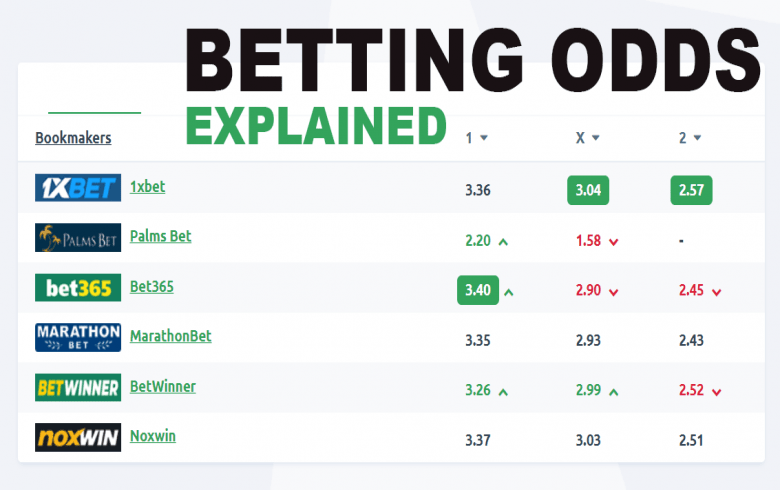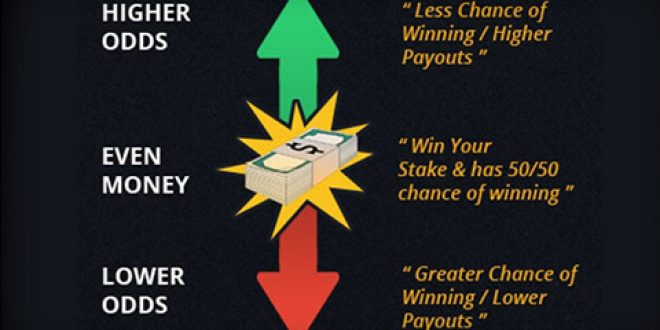How does betting odds work in sports

This is how punters can use how does betting odds work in sports betting odds to work out how likely bookmakers believe an outcome is to happen. How to calculate probability. Secondly, sports betting odds will show the amount a bettor has to wager to make a profit. Sportsbooks try to keep both sides as even as possible. Not only will. As you can see, the odds in sports betting vary massively based on each team's probability of winning. It's implied that some aren't even worth. Sports betting odds, in the simplest terms, are reflections of the probability of a certain event occurring. As a result, they also determine.
Betting Odds in Sports: Deciphering the Numbers
Sports betting has become a phenomenon that intertwines the thrill of competition with the possibility of financial gain. Central to the world of sports betting are the odds, which essentially serve as the backbone of any betting market. For those uninitiated, comprehending betting odds might seem like deciphering an ancient code, but in reality, it's a structured system with its own logic.
When you enter the realm of sports wagering, you encounter three main types of odds - decimal, fractional, and American (Moneyline).
Decimal Odds: Easily recognizable in their format, decimal odds represent the amount you win for every $1 wagered, including your stake. For instance, odds of 2.00 would mean you double your money if your bet is successful.
Fractional Odds: Predominantly used in the United Kingdom, fractional odds appear as a fraction, denoting your potential winnings relative to your stake. If the odds are 5/1, you stand to receive $5 for every $1 wagered, plus your original stake.
American (Moneyline) Odds: Commonly seen in the USA, American odds can be either positive or negative. Positive odds indicate the potential profit on a $100 bet, while negative odds represent the amount you need to bet to win $100.
Understanding how to read and interpret odds is crucial, as they not only reflect the probability of a particular outcome but also dictate potential returns. Bookmakers analyze a myriad of factors to determine these odds, including statistical data, team form, and expert insights.
Furthermore, odds are influenced by the betting market itself. As more punters back a certain outcome, the odds tend to shorten, reflecting a higher likelihood of that event occurring. Conversely, a lack of interest in a particular outcome can lead to longer odds.
When it comes to placing a bet, knowing how to interpret odds is imperative. Making informed decisions based on the odds can enhance not only your chances of winning but also your overall experience in the thrilling world of sports betting.
In conclusion, betting odds serve as the cornerstone of sports wagering, blending excitement with strategy. By mastering the art of understanding odds, punters can navigate the intricacies of the betting landscape and make calculated predictions to secure winning bets.
Betting Odds Explained: Beginners Guide on How to Understand Betting Odds
How do sports betting odds work for dummies? The number that follows the negative symbol (the odds) reveals how much to bet for every $100 you want to win. For example, if the team you're betting on has -110 odds, you need to wager $110 to win $100. If your team has -150 odds, you must risk $150 to win $100.
What does 125 odds mean? If you were to bet $10 on +125 odds you would receive $12.50 in profit if this outcome won. Odds accompanied with a positive sign (+) indicate that this is the underdog and this outcome will have a lower chance of winning compared to a favorite, however underdogs will yield a higher profit if they win.
How to read odds? For favored bets, the bet odds will start with a negative number and they tell you how much you need to bet to win $100. If the odds are -110, a common number for a bet involving a spread, you would need to bet $110 to win $100. If the odds are positive, they tell you how much you will win if you bet $100.
Is one in 10000 good odds? "1 in 10,000" is a very rare event and people are not good at dealing with rare events - mainly because they don't meet them very frequently (by definition).
How are sports betting odds calculated? Unlike American or fractional odds, decimal odds are always a positive number, and they're always greater than 1. Decimal odds represent the potential winnings for a $1 bet, including the stake. So, for decimal odds of 1.5, you'd receive $1.5 from a $1 bet, the return of your $1 stake plus a 50 cent profit.
Can someone explain betting odds? Simply put, the greater the odds against a team, the larger the payout will be for anyone who bets on it. For example, 7 to 2 odds mean that for every $2 you wager, you could win $7 if your bet is successful, while 5 to 1 odds mean you could win $5 for every $1 you bet.
How do betting odds work? How to calculate sports betting odds
Bettors must also have a comprehensive understanding of how to read betting odds before placing any wagers. To determine how much to risk to profit a certain amount with negative odds, the simplest way is converting odds to decimals. Implied probability is evaluated based on the odds of the event occurring. The higher the percentage, the more likely the event is to occur.
With American and moneyline odds, the implied probability equation is different for both favorites and underdogs negative and positive numbers. That equals 0. Wagering on odds would require the bettor to win at least 90 percent of the time to make a long-term profit. The quotient would result in.
For an example using decimal odds, the formula is dividing 1 by the odds. If a team has odds of 1. Odds on all types of bets can change often for a variety of causes. The odds are usually shifted in favor of the opposing team. Reading sports betting odds is a critical skill to understand when planning to place a bet.
Both moneyline and American are displayed with a plus sign and minus sign next to a number. Negative numbers represent the favored outcome while positive numbers indicates the underdog. Fractional odds are often displayed as fractions representing the numerator as the amount a bettor could win divided by the denominator including the amount wagered.
Read on to learn more. Wagers on underdogs, which always have positive odds, are typically more likely to lose. However, a winning bet will produce a bigger profit with a higher payout. How does betting odds work in sports It can also be represented with a colon or dash. The numerator represents the amount a bettor could win divided by the denominator, the amount wagered. Following the formula of multiplying the amount wagered by the divided fraction will calculate the payout.
Implied probability in sports betting is an important concept to understand when looking at odds. American, fractional, and decimal odds tell you how likely oddsmakers think one team is to win. Implied probability allows you to calculate how often your bet will need to cash for it to be profitable.
For American odds, the equation is different for favorites and underdogs. That equals That means a favorite has to win If the decimal odds are 3. Before the proliferation of online sports betting , all the odds used to be set by a handful of powerful Vegas casinos. Now all the big online shops have their oddsmakers, but Vegas is still a major factor.
If you purchase a product or register for an account through a link on our site, we may receive compensation. Sidelines Group provides sports betting and casino content to MLive, including game predictions, odds, analysis, and sportsbook and casino reviews to educate bettors. Please bet responsibly.  How do betting odds work. Still confused. Let's dive deeper.
How do betting odds work. Still confused. Let's dive deeper.
It scales up and down depending on your bet amount. You can explore this concept further by using the BetMGM bonus code to try it out. Let's use Penn State vs. Ohio State in college football as an example, with odds from DraftKings. Ohio State is the perceived stronger team in this game, so the Buckeyes are the favorite at DraftKings.
Remember, OSU just needs to win the game. Since the moneyline just requires you to pick a winner, we only need the odds. We don't need a point spread or line of any kind. If the Nittany Lions lose by points or win the game, you win your bet. For lower-scoring sports, the point spreads will be low often Around the world, most sportsbooks and bettors use decimal odds or fractional odds.
Here's how they work. Decimal odds: Your total return for every dollar risked including that dollar. Anything above 2. So if the Jets are 2. Fractional odds: Fractional odds are still used in horse racing, so they're not totally unusual to American bettors. These are pretty straight forward.
Divide the fraction into a number, then multiple by your bet amount.
Popular Pages
- Is sports betting legal in uk
- How does a sport betting handicap work in rugby
- How to sports bet online in california
- How to buy cryptocurrency for sports betting
- How to make money on sports spread betting
- When will pa get sports betting
- How much money to start sports betting
- Where to bet sports in iowa
- Where can you bet on sports in indiana
- How to open a sports betting site